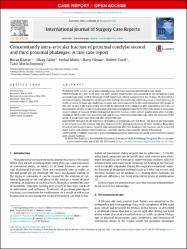| dc.contributor.author | Kömür, Baran | |
| dc.contributor.author | Güler, Olcay | |
| dc.contributor.author | Mutlu, Serhat | |
| dc.contributor.author | Yılmaz, Barış | |
| dc.contributor.author | Yücel, Bülent | |
| dc.contributor.author | Mutlu Duymuş, Tahir | |
| dc.date.accessioned | 2020-07-14T12:07:30Z | |
| dc.date.available | 2020-07-14T12:07:30Z | |
| dc.date.issued | 2016 | en_US |
| dc.identifier.citation | Kömür, B., Güler, O., Mutlu, S., Yılmaz, B., Yücel, B. ve Mutlu Duymuş, T. (2016). Concomitantly intra-articular fracture of proximal condylar second and third proximal phalanges: A rare case report. International Journal of Surgery Case Reports, 24, 94-96. https://dx.doi.org/10.1016/j.ijscr.2016.05.013 | en_US |
| dc.identifier.issn | 2210-2612 | |
| dc.identifier.uri | https://dx.doi.org/10.1016/j.ijscr.2016.05.013 | |
| dc.identifier.uri | https://hdl.handle.net/20.500.12511/5490 | |
| dc.description.abstract | INTRODUCTION: A rare case of proximal phalange fractures has been presented in this study. PRESENTATION OF CASE: A 29-year-old male patient from Turkey was admitted to the orthopedics and traumatology clinic with a complaint of left hand pain, which had persisted for 10 days. He described a rotationaltrauma that had occurred right after hitting his hand on the wheel of a car as a result of an in-car traffic accident 10 days ago. Radiological work-ups were requested. In the anteroposterior (AP) graph of the case in which the fracture line could not be observed in the oblique graph, unicondylar fractures in the proximal section of the second and third proximal phalanges have been observed. Surgical treatment was not planned because 10 days had passed since the trauma. In the control graphs taken after 3 weeks, healing at the fracture site was observed, and he was referred to physiotherapy after the removal of the splint. A good result was observed after physiotherapy. DISCUSSION: Because of the extension of tendons is important over the bone, the goal of the treatment is not only to heal the fracture, but also to preserve the sliding mechanism of these tendons. Regarding to lack of soft tissue trauma, favored joint movements after the healing of the fracture can be achieved more easily with conservative treatment; however, the fracture must be closely followed up. CONCLUSION: Condylar fractures of proximal phalanges those nondisplaced can be conservatively treated with closed methods. | en_US |
| dc.language.iso | eng | en_US |
| dc.publisher | Elsevier | en_US |
| dc.rights | info:eu-repo/semantics/openAccess | en_US |
| dc.rights | Attribution-NonCommercial-NoDerivatives 4.0 International | * |
| dc.rights.uri | https://creativecommons.org/licenses/by-nc-nd/4.0/ | * |
| dc.subject | Proximal Phalange Fracture | en_US |
| dc.subject | Condylar Fracture of Phalanx | en_US |
| dc.subject | Conservative Treatment | en_US |
| dc.title | Concomitantly intra-articular fracture of proximal condylar second and third proximal phalanges: A rare case report | en_US |
| dc.type | article | en_US |
| dc.relation.ispartof | International Journal of Surgery Case Reports | en_US |
| dc.department | İstanbul Medipol Üniversitesi, Tıp Fakültesi, Cerrahi Tıp Bilimleri Bölümü, Ortopedi ve Travmatoloji Ana Bilim Dalı | en_US |
| dc.authorid | 0000-0002-0022-0439 | en_US |
| dc.identifier.volume | 24 | en_US |
| dc.identifier.startpage | 94 | en_US |
| dc.identifier.endpage | 96 | en_US |
| dc.relation.publicationcategory | Makale - Uluslararası Hakemli Dergi - Kurum Öğretim Elemanı | en_US |
| dc.identifier.doi | 10.1016/j.ijscr.2016.05.013 | en_US |
| dc.identifier.scopusquality | Q3 | en_US |




















